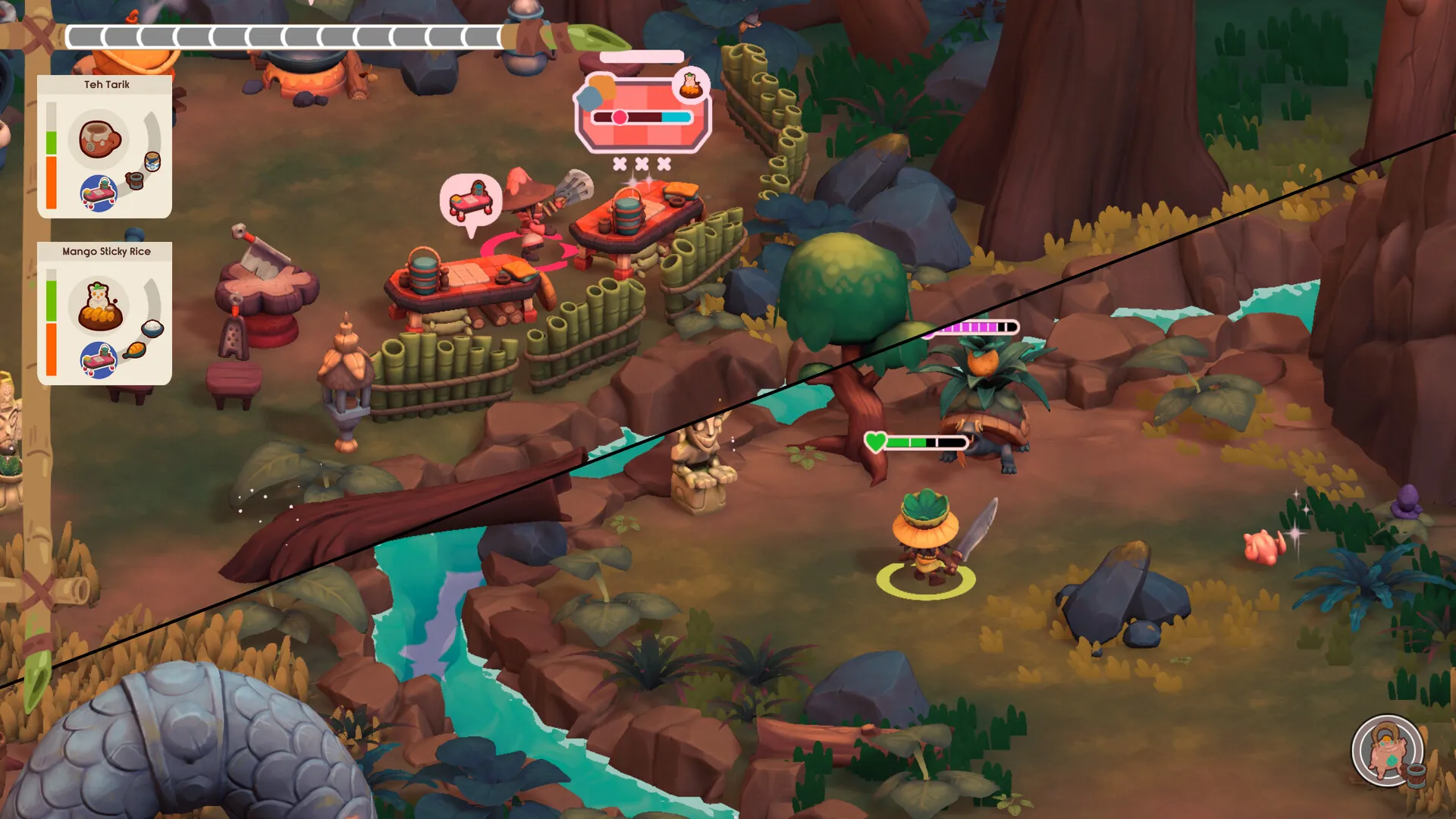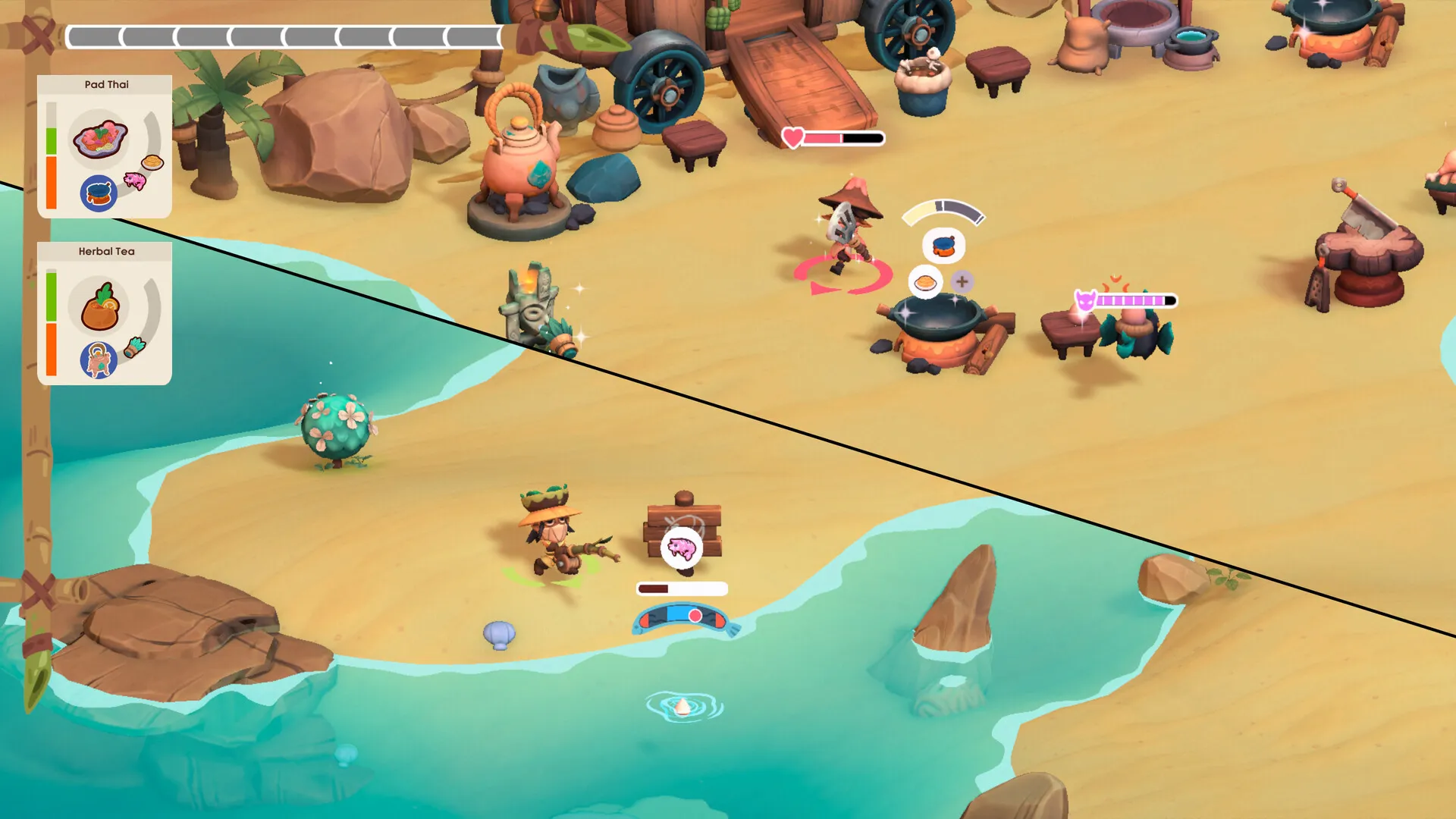The chaotic cooking genre often relies on a simple formula: take a kitchen, add four frantic players, and watch the mayhem unfold. SEDAP! A Culinary Adventure takes this recipe and infuses it with a potent ingredient that many of its peers lack: a deep, authentic cultural identity.
This is a fast-paced co-op game centered entirely on the vibrant world of Southeast Asian cuisine. We follow the enthusiastic duo of Som, the cook, and Gon, the hunter, as they venture to the magical island of Khaya.
Armed with a mystical cookbook called the Makanomicon, their goal is to master new dishes and revitalize their family business by serving customers who demand both speed and quality. The game immediately sets a tone of frenzied, flavorful fun, preparing you for an adventure where the ingredients might just fight back.
A Kitchen Built for Two
The central design pillar of SEDAP! is its strict division of labor, a mechanic that defines both the gameplay and the narrative of two friends working together. Som is the culinary artist, most efficient when preparing ingredients and working the various cooking stations.
Gon is the rugged survivalist, excelling at hunting down mobile ingredients and dispatching monsters that invade your workspace. This system is a departure from the jack-of-all-trades model seen in games like Overcooked, forcing players into specialized roles. This choice means success hinges on communication and dependency, not just individual skill.
The pressure is constant, with relentless order timers and ingredients that spoil if left for too long. While the three-button control scheme is accessible, complexity arises from the multi-step recipes, each requiring specific equipment and often involving frantic minigames or quick-time events.
Successful service yields money, which can be used to purchase powerful upgrades. These provide a tangible sense of progression and player agency, allowing you to invest in tools that might just give you the edge in the next demanding level.
More Than a Meal: A Cultural Canvas
Where SEDAP! truly distinguishes itself is in its presentation and heartfelt celebration of its theme. The world of Khaya is brought to life with a colorful and charming art style. Character models are stylized with expressive outlines during dialogue, and the environments are lush and whimsical.
The ingredient design is particularly creative, featuring creatures like pineapple-turtles and weeping ginger roots that you must chase down. The soundscape complements this visual charm perfectly; the menu music is catchy, ambient sounds create a relaxing hub world, and the cooking effects are crisp and satisfying. This aesthetic shell houses a rich cultural core.
The game is an interactive tour of Southeast Asian food, featuring real-world dishes like Hainanese chicken rice, teh tarik, and Laksa Sarawak.
Unlike games where the theme is merely a coat of paint, here it is the main event. The act of learning about and creating these dishes provides a motivation beyond simply beating a timer. The inclusion of customer reviews at the end of a level, reacting to your food, is a small but effective touch that deepens the immersion.
The Co-op Imperative
Be warned: SEDAP! is a co-op game through and through. The entire experience, from its level design to its core mechanics, is built for two players working in tandem. Many stages feature obstacles that require synchronized actions, and the difficulty ramps up with the assumption that two people are managing the chaos.
Playing with a partner feels like the intended path, where the frantic back-and-forth between Som and Gon creates a dynamic rhythm. While a solo mode exists, it feels less like an alternative and more like a grueling challenge. The constant need to switch between characters to hunt, gather, cook, and serve is overwhelming for a single player.
The game makes minor concessions, such as automatically keeping certain gates open, but the fundamental pressure remains immense. Even with a partner, the challenge is considerable. Tight coordination is a necessity, and the dynamic split-screen camera, which uses a rotating separator, can be disorienting for newcomers before they grow accustomed to its flow.
The Final Dish – Frantic but Flavorful
The game’s appeal is in its potent combination of high-energy action and its sincere focus on Southeast Asian culture. It’s a compelling package, though not without a few small blemishes.
The difficulty can be punishing, and a slight input lag can occasionally lead to frustrating mistakes during precise cooking actions. Some of the cooking minigames are not explained clearly, requiring some trial and error.
A notable oversight is the lack of separate save files, meaning your solo and co-op progress are tied together. Even with these issues, the experience is highly replayable and deeply engaging for pairs seeking a high-stakes cooking challenge. Mastering the intricate recipes and chasing perfect scores provides a powerful hook that will keep you and a friend coming back to the kitchen.
The Review
SEDAP! A Culinary Adventure
SEDAP! A Culinary Adventure is a vibrant and chaotic co-op game that succeeds brilliantly as a shared experience. Its core strength lies in its celebration of Southeast Asian cuisine, wrapped in a charming aesthetic and a demanding, role-based gameplay loop. While it’s an absolute feast for two, the punishing difficulty and design choices make it a frustrating and lonely kitchen for the solo player. It’s a dish best served with a friend.
PROS
- Engaging co-op gameplay built on distinct character roles.
- A wonderful and authentic celebration of Southeast Asian culture and food.
- Charming, colorful art style and pleasant sound design.
- High replay value through upgrades and the challenge of perfecting each level.
CONS
- The solo player experience is exceptionally difficult and not recommended.
- A steep difficulty curve can feel punishing even in co-op.
- Minor technical issues, including a sometimes-disorienting camera and unclear minigames.
- No separate save files for individual and cooperative progress.


















































